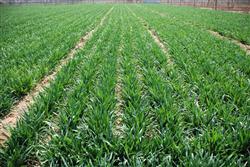How to prevent wheat from freezing in spring?

After wheat entered the green stage, from the temperature-sensitive stage to the photosensitive stage, the cold resistance of wheat seedlings decreased significantly. Once the late spring cold was encountered, the plants were very vulnerable to freezing injury. For this reason, several effective anti-freezing methods are introduced in combination with the management of wheat fields in early spring. Paddling hoe can loosen the soil, preserve soil moisture, increase temperature, weed, and enhance the ability of wheat seedlings to protect against cold. It is observed that the average soil temperature in the 5 cm soil layer increases by 0.5 ℃ ~ 1 ℃ in the daytime from 7 to 10 days after hoing, which is very beneficial to promote root development and nutrient transformation. Therefore, no matter weak seedlings, strong seedlings or strong seedlings, we should pay close attention to hoeing during the period of turning green, and for wheat fields with a trend of prosperity and growth, we can also dig deep enough to restrain tillering in spring. When ploughing, we should pay attention to mastering shallow hoe and fine hoe, and push the bumpy hoe away while hoing; if we suppress the soil before ploughing, the soil will not be empty, thus achieving the effect of loosening and lowering fruit, increasing soil moisture and preserving soil moisture. The suppression of wheat fields in early spring can crush bumps, close cracks, close wheat roots and soil, and prevent cold air from invading and harming wheat seedlings. At the same time, suppression also has the effect of increasing soil moisture, which can increase the water content of soil surface and reduce low temperature chilling injury. Fertilization in early spring can make up for the soil fertility consumption in winter, increase the accumulation of nutrients, promote the green growth of wheat seedlings, and resist or reduce the freezing injury in early spring. When fertilizing wheat in early spring, we should seize the favorable opportunity that the soil has just thawed and apply it deeply by opening ditches with soil moisture. Generally, it should not be watered so as not to reduce the ground temperature and affect the growth of wheat seedlings. Spraying 200 × 10 ~ (- 6) paclobutrazol solution (30kg / mu) can inhibit the growth of wheat seedlings and enhance the ability of cold resistance.
- Prev

Nine methods of seed treatment of wheat before sowing in spring
With the warming of the climate, wheat has gradually entered the stages of turning green, getting up and jointing, which is not only an important period for wheat to promote the growth of weak seedlings, control and steady growth, but also the key stage for the prevention and control of wheat diseases and insect pests. In view of the occurrence characteristics and existing problems of wheat diseases, pests and weeds this year, recently, the reporter interviewed the northwest.
- Next

Matters needing attention in Peanut planting
Matters needing attention in Peanut planting
Related
- The first cup of black tea in spring, the flavor and history of tea gardens in Kenya, Africa
- The computer can not only choose potatoes, but also grow tea rice. AI will grow winter oolong tea champion.
- It is not only the inflated tea bitten by insects, but also engraved with the four seasons tea in Beipu.
- The Oriental Beauty Tea Festival in Zhuxian County takes the stage at the weekend to experience the plus-size feast of oil tea.
- & quot; Oriental Beauty Tea & Exploration of Emei in Hsinchu, the hometown of quot;
- The new variety of strawberry "Tainong 1" dessert is the first choice with mellow aroma. Crimson gorgeous
- History of Tea in Taiwan: from Wild Inner Mountain to Export Tea Garden
- Two types of Taiwan Oriental Beauty Black Tea won the British three-Star Award for Childhood Tea Xiang Zhang Jiaqi changed from pilot to champion tea maker.
- Banana species and varieties: the planting history of Taiwan Xianren banana and dwarf banana is long, is banana disease resistant?
- Coffee planting Technology: Qianjie Coffee from Seedling to harvesting

